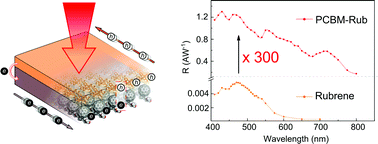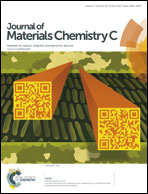Enhanced conductivity and photoresponse at a rubrene single-crystal–PCBM film interface†
Abstract
A large photoresponse is observed at the interface between a highly ordered rubrene single-crystal and an amorphous fullerene film, with responsivity values 300 times higher than the corresponding bulk-heterojunctions and an isolated single-crystal. The rubrene–PCBM interface displays a wide range photoresponse, particularly enhanced in the red part of the visible spectrum presenting an exceptionally high photogeneration yield for lower excitation energies. Increased dark conductivity and electronic structure calculations indicate a polarization effect that reduces the band-gap and assists interfacial exciton separation to donor and acceptor layers well apart, minimizing electron–hole recombination. Wavelength-dependent photoconductivity and thickness-dependent absorption measurements, supported by computational analysis, show that primary excitons formed in rubrene and PCBM evolve to excitons which are effectively separated at the interface. Our results provide important insights into harnessing excitons generated in both the electron donor and acceptor materials increasing the efficiency in organic devices.


 Please wait while we load your content...
Please wait while we load your content...